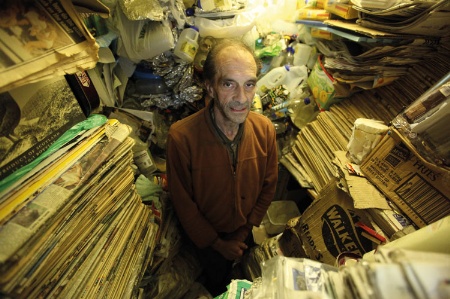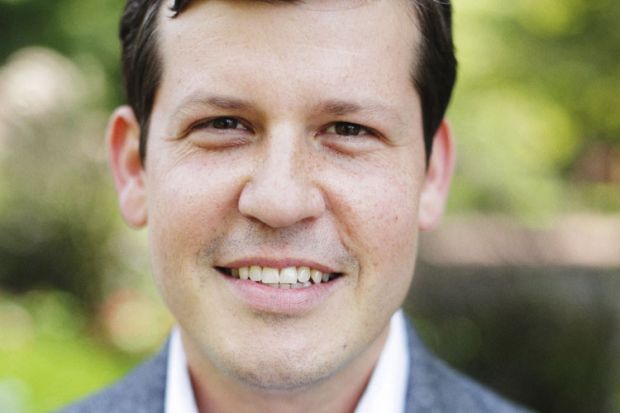Scott Herring, author of The Hoarders: Material Deviance in Modern American Culture
What are the cultural factors, the fears and fantasies that underlie our discomfort with hoarders and our desire to declare them mad?
When Homer Collyer, a reclusive 66-year-old resident of New York’s Harlem district, died at home in 1947, the state of his house created a news sensation. The rotting corpse of his brother, Langley, was found not far from his, trapped under a collapsed pile of newspapers rigged up to deter intruders. Among the startling mountains of detritus, reported Time magazine, “the police found five grand pianos, a library containing thousands of books on law and engineering, ancient toys, old bicycles with rotting tires, obscene photographs, dressmaker’s dummies, heaps of coal and ton after ton of newspapers”. The story fascinated the nation to such an extent that “Collyer brothers syndrome” became a common term for their particular style of housekeeping.
The Collyers are the first in a series of “pack rats, extreme accumulators and clutter addicts” examined by Scott Herring in his new book, The Hoarders: Material Deviance in Modern American Culture. Such people, he notes, were officially classified and pathologised in the fifth (2013) edition of the psychiatric bible, Diagnostic and Statistical Manual of Mental Disorders (DSM), under the label of “hoarding disorder”. Other experts have carried out MRI scans and argue that hoarders can be identified by “irregularities in their brain’s anterior cingulate cortex”.
But what lies beneath this medicalising of hoarding behaviour? What are the cultural factors, the fears and fantasies that underpin our discomfort with hoarders and our desire to declare them mad? Those are the central questions that Herring – an associate professor in the department of English at Indiana University Bloomington – sets out to answer.
After two books squarely in the field of lesbian, gay, bisexual and transgender (LGBT) studies, The Hoarders is something of a departure for Herring. Yet he also believes there are important links with his previous work.
When he was an undergraduate at the University of Alabama at Birmingham, Herring was influenced by “phenomenal teachers” who were very supportive of the field of LGBT studies “at a moment of heightened panic over the HIV/AIDS epidemic”. He still sees himself as both a “recorder” of lost gay and lesbian history and an “advocate” for the discipline, and his two earlier books fit neatly into that bracket. Queering the Underworld: Slumming, Literature, and the Undoing of Lesbian and Gay History (2008) explores the work of the mainly heterosexual “slummer” journalists and writers of the 1920s, who descended into the “underworld” of various sexual subcultures and produced reports, both fascinated and horrified, of “how the other half lives”. More overtly personal is Another Country: Queer Anti-Urbanism (2010), in which Herring describes himself as “a lower-middle-class queer white male from a [small] town”.
“As someone who grew up outside the metropolis,” he explains to me, “I wanted to think about individuals who are often marginalised by the ‘flight to the city’ narrative.” Forging an academic career meant “having to leave behind certain forms of queer life that I very much enjoyed in Alabama but which are sometimes dismissed by individuals who believe that New York and Los Angeles are the epicentre of gay and lesbian life. I wanted to pay homage to those neglected, non-metropolitan spaces, which can be vital for individuals and should be recorded and celebrated even if they can also be spaces of homophobia.”

Yet Herring believes that LGBT studies have gone beyond illuminating sexuality and gender and are now “extraordinarily rich in resources for understanding how social norms and social deviation happen. I am interested in how norms and deviation apply not only to gay and lesbian people but to our relations to things as well. The DSM pathologised lesbians and gays in its first publication in 1952, so it’s interesting to think about the overarching discourse of pathology and normalisation and how it happens.”
In turning to hoarders and the anxieties they provoke, Herring sees himself as building on these intellectual interests. But, as he explains in the preface to his new book, he also wants to reflect on a significant early experience. When he was a child, he was occasionally taken to visit the street where his mother grew up. The route took him past a large residence with a garden full of litter said to be owned by a reclusive eccentric known locally as the Rat (or Pack Rat) Man. Although he never saw anyone enter or exit, he began to imagine “a lonely male draped in black with a white bandage wrapped around his head” – a nightmare image probably inspired by John Hurt’s portrayal of Joseph Merrick in David Lynch’s 1980 film, The Elephant Man.
“He inspired fascination, dread and no small amount of revulsion,” Herring writes. “His house was far different from my suburban home, which was vacuumed regularly and dusted weekly. A photograph of our smiling family hung in the hallway. The living room harboured an antique curio cabinet filled with keepsakes: framed wedding photos, bronze-dipped baby shoes, a Hallmark holiday ornament. The only clutter in sight was a pile of magazines or some overdue self-help books checked out from the downtown library. My house read ‘normal’; the Rat Man’s read ‘cracked’.”
Herring is explicit that he “doesn’t identify as a hoarder” but sees himself too as “caught up in the idea of an acceptable material life”. He wanted to investigate “where my own revulsion, terror and fascination with [certain hoarders] came from. How do I understand my visceral terror of the Pack Rat Man? Where did that come from historically? I wanted to understand the cultural history of hoarding through a series of celebrity [hoarders] who became almost legendary stereotypes or cultural models for how we [feel about] those identified as hoarders today.”
Along with the Collyers, The Hoarders considers the case of Edith Ewing Bouvier Beale and her daughter Edith Bouvier Beale – close relatives of Jacqueline Kennedy/Onassis – whose house was raided in 1971 and turned out to contain “a surplus of cats, evidence of semi-domesticated raccoons, a five-foot-high mound of empty cans and furniture in tatters”, along with its “two impoverished white women”. He also looks at “professional organisers” who offer decluttering services, and the Messies Anonymous self-help group. And he reflects on the sheer oddity of the vast collection accumulated by Andy Warhol, in which one is as likely to find a discarded bubblegum wrapper as an artwork by Edvard Munch.

Despite the fact that the Collyers were white and from a well-to-do background, the way they were discussed, the book argues, is symptomatic of outsiders’ fears of largely black, working-class 1930s Harlem. Some other “celebrity hoarding cases” attracted commentary that Herring links to “post-1960s New Christian Right literatures”. Such literatures are seldom innocent. Manuals such as Sandra Felton’s bestselling 1981 book, The Messies Manual: The Procrastinator’s Guide to Good Housekeeping, were “publicised alongside evangelical tracts that promote ex-gay movements, antiwomen’s studies and Christian house decorating, and much as they function as embattled wars against clutter, they also operate as hymns to devout domestic living”. So-called experts’ attempts to define and stigmatise “hoarding” often depend on a difference between “normal” collecting and an excessive, undiscriminating variety, as if this reflected some universal distinction when, in reality, it relies on class-based and very historically specific ideas of what count as proper “collectibles”.
Herring hopes that by exploring and exploding such discourses, he can “depathologise” hoarding. He acknowledges that it can “wreck lives and harm interpersonal relations” and that its addition to the DSM may bring both psychological and practical succour to some hoarders. But “for others it may be a mark of social stigma and shame. I wanted to put that out there.”
And what of Herring’s day job as an academic? There is a traditional link between hoarding and pedantry, sometimes expressed in the idea of an anal retentive personality, and it is not difficult to find old-time professors whose living spaces are almost as completely colonised by papers and books as the Collyers’ brownstone house.
The Hoarders makes a point of stating that its author’s “core archives fit into a knapsack”, but Herring is “not entirely convinced by the connection between anal eroticism and a full bookshelf”. However, the book has another implication for academics when it suggests that there is a continuum stretching from diagnostic manuals and scientific analyses of hoarding all the way to the sensationalist reality television shows where hoarders are identified, shamed and “cured”.
“It might be an unintentional side-effect of the research,” he explains, “[but] under the guise of further refining our understanding of the ‘disease’, the hoarding experts in psychology, psychiatry and social work may actually create more anxiety about it.”
To suggest how this works, Herring falls back on the notion of “moral panics” formulated by the late London School of Economics sociologist Stan Cohen.
“Cohen talks about noisy and quiet moral panics. A very noisy moral panic might be about the most extreme instance of a compulsive hoarder, the worst of the worst,” held up for ridicule in the popular media. “But there’s also a quiet moral panic that can happen in a scientific journal, where individuals may begin to standardise this ‘disease’, presenting it as an abnormality or a psychopathology.”
Part of his job as a cultural critic, Herring believes, is precisely to take such ideas out of the realm of scientific discourse and hold them up to the light.
Register to continue
Why register?
- Registration is free and only takes a moment
- Once registered, you can read 3 articles a month
- Sign up for our newsletter
Subscribe
Or subscribe for unlimited access to:
- Unlimited access to news, views, insights & reviews
- Digital editions
- Digital access to THE’s university and college rankings analysis
Already registered or a current subscriber? Login

